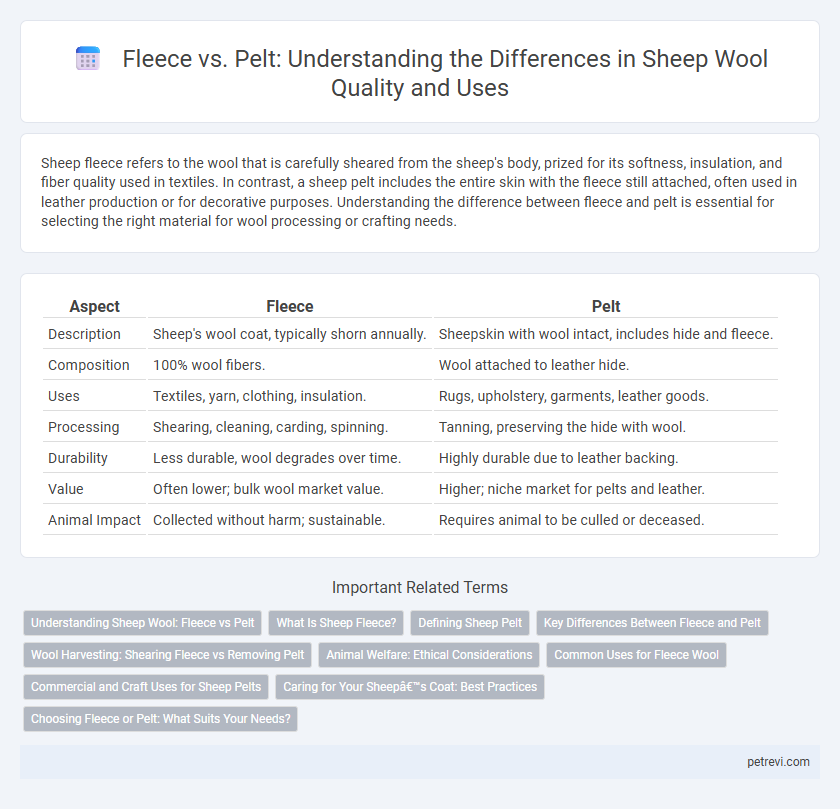Sheep fleece refers to the wool that is carefully sheared from the sheep's body, prized for its softness, insulation, and fiber quality used in textiles. In contrast, a sheep pelt includes the entire skin with the fleece still attached, often used in leather production or for decorative purposes. Understanding the difference between fleece and pelt is essential for selecting the right material for wool processing or crafting needs.
Table of Comparison
| Aspect | Fleece | Pelt |
|---|---|---|
| Description | Sheep's wool coat, typically shorn annually. | Sheepskin with wool intact, includes hide and fleece. |
| Composition | 100% wool fibers. | Wool attached to leather hide. |
| Uses | Textiles, yarn, clothing, insulation. | Rugs, upholstery, garments, leather goods. |
| Processing | Shearing, cleaning, carding, spinning. | Tanning, preserving the hide with wool. |
| Durability | Less durable, wool degrades over time. | Highly durable due to leather backing. |
| Value | Often lower; bulk wool market value. | Higher; niche market for pelts and leather. |
| Animal Impact | Collected without harm; sustainable. | Requires animal to be culled or deceased. |
Understanding Sheep Wool: Fleece vs Pelt
Sheep wool is derived primarily from two sources: fleece and pelt, each offering distinct characteristics. Fleece refers to the wool shorn from the sheep, typically soft, dense, and suitable for textile production, while pelt includes the skin and attached wool, often utilized in leather goods with more coarse fibers. Understanding the differences in fiber length, texture, and application between fleece and pelt helps optimize the use of sheep wool in various industries.
What Is Sheep Fleece?
Sheep fleece refers to the woolly coat harvested from sheep, prized for its softness, insulation, and versatility in textiles. Unlike a pelt, which is the entire skin with hair or wool attached, fleece is sheared off the sheep without harming the animal, making it a renewable resource. The quality of sheep fleece varies by breed, with Merino fleece known for its fine, dense wool ideal for high-end clothing and insulation.
Defining Sheep Pelt
Sheep pelt refers to the entire skin of the sheep, including the wool or hair attached, typically preserved through tanning or curing processes to create leather or sheepskin products. Unlike fleece, which is the wool shorn from the sheep without the skin, pelt retains the natural structure that combines both the hide and fiber, offering dual-purpose use in fashion and upholstery. The quality of sheep pelt depends on factors such as breed, age, and handling, affecting the texture, durability, and value of the final leather and wool products.
Key Differences Between Fleece and Pelt
Fleece refers to the wool shorn from a sheep, characterized by its softness, crimp, and fiber length, primarily used for textile production. Pelt, on the other hand, includes both the wool and the sheep's skin, often utilized in leather goods and sheepskin products, providing durability and texture. The key difference lies in fleece being purely wool for fabric creation, whereas pelt combines skin and wool for versatile material applications.
Wool Harvesting: Shearing Fleece vs Removing Pelt
Sheep wool harvesting primarily involves shearing the fleece, which preserves the fiber's natural quality and length, unlike removing the pelt that includes the skin and can damage wool fibers. Shearing fleece allows for renewable wool collection annually without harming the sheep, ensuring sustainability and animal welfare. Removing the pelt is less common in wool production as it often results in lower-quality fibers and is typically associated with meat or hide industries rather than textile purposes.
Animal Welfare: Ethical Considerations
Fleece provides a more ethical option for harvesting sheep wool as it involves shearing the sheep, allowing the wool to regrow naturally without harm. In contrast, obtaining a pelt requires the animal to be slaughtered, raising significant animal welfare concerns. Prioritizing fleece over pelt supports sustainable practices that respect the well-being and life of the sheep.
Common Uses for Fleece Wool
Sheep fleece wool is primarily valued for its softness, elasticity, and insulation properties, making it ideal for textiles such as clothing, blankets, and upholstery. Unlike pelts, which retain the skin and are used in leather production, fleece is sheared and processed into yarns and fabrics that emphasize comfort and warmth. Common uses for fleece wool include knitting, weaving, and felting applications, where its lightweight and breathable qualities enhance consumer products.
Commercial and Craft Uses for Sheep Pelts
Sheep pelts, prized for their durability and unique texture, offer commercial advantages in producing high-quality rugs, upholstery, and insulated clothing, contrasting with fleece that is predominantly used in textile manufacturing and garment production. Craft enthusiasts value pelts for their natural lanolin content and distinctive grain, making them ideal for handmade leather goods, drum covers, and traditional clothing accessories. The commercial demand for pelts continues to grow due to their versatility and natural aesthetics, complementing fleece's role in the wool industry.
Caring for Your Sheep’s Coat: Best Practices
Sheep fleece requires regular shearing to maintain hygiene and prevent overheating, while pelts, being the sheep's untreated skin and wool, demand careful handling to avoid damage. Proper grooming with natural oils and appropriate feed supports wool growth and coat health, reducing the risk of matting and parasites. Ensuring clean living conditions and routine health checks enhances the quality and longevity of both fleece and pelts.
Choosing Fleece or Pelt: What Suits Your Needs?
Choosing between fleece and pelt depends on your desired wool quality and processing method; fleece offers clean, shorn wool ideal for spinning and felting, while pelt includes the entire skin with fiber, providing durability for leather and rug production. Fleece ensures softer, more uniform fibers suitable for textiles, whereas pelt retains lanolin and skin layers, affecting texture and application. Consider fleece for fine wool projects and pelt for stronger, rugged materials to match your creative or commercial needs.
Fleece vs Pelt for Sheep Wool Infographic

 petrevi.com
petrevi.com